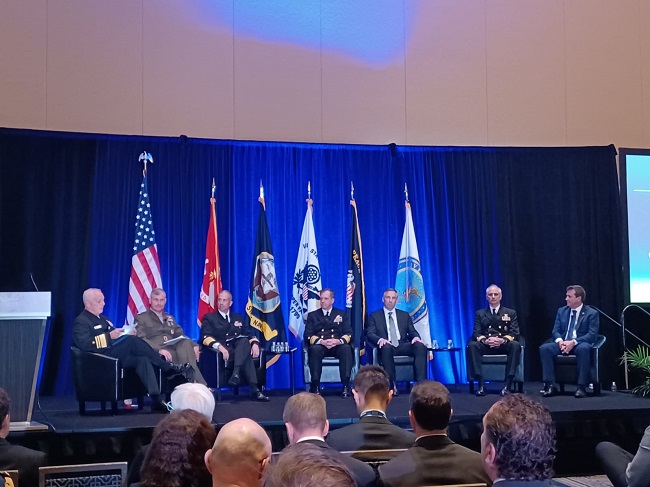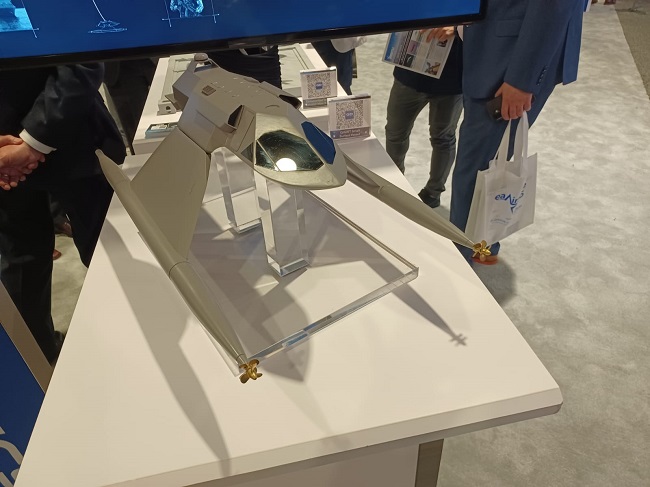
From April 7–9, the Sea Air Space Conference and Exhibition took place at the Gaylord National Harbor in Maryland, United States.
As the exhibition concludes, FW MAG reflects on key trends shaping the US aerospace and naval sectors, particularly in the context of the US Navy's ongoing transformation. This modernisation effort is driving a wave of innovation across the entire defence industry—from shipbuilding to satellite technologies. In the coming weeks, FW MAG will offer a reasoned, analytical overview of the many programmes and projects showcased in Maryland.
The US Navy's transformation is unfolding on 2 main fronts. As global tensions escalate, Carrier Groups are reclaiming their role as the cornerstone of American naval power, both for power projection and sea control. During a panel on the future of naval aviation, Vice Admiral Carl Chebi, Commander of the Naval Air Systems Command, stressed that the Navy must ensure the President of the United States maintains "complete decisional independence from any other countries and is empowered to act autonomously and pursue all the opportunities he deems appropriate to the best interest of the country." A classic take, reinforcing the return of power politics and the necessity of confronting top-tier adversaries.
In terms of Order of Battle (OOB), this shift involves empowering Carrier Air Groups with the most effective mix of assets and the highest possible level of combat readiness to deliver unmatched firepower.
At the core of this doctrine are the FORD-class aircraft carriers, which will deploy an increasingly sophisticated blend of manned and unmanned aircraft—reviving capabilities eroded by decades of low-intensity operations. The F/A-18E/F SUPER HORNET and the F-35B/C will remain the backbone of air wings, but they will be complemented by expanded AEW&C, ASW, ISR, and transport capabilities. This rebalancing has wide-ranging implications for both the quantity and quality of deployed assets. For instance, the resilient E-2D HAWKEYE continues to be upgraded, and an unmanned platform could join it in the coming decade. Meanwhile, ISR, EW, and ASW missions could be assigned to remotely piloted or autonomous aircraft, potentially taking over roles once carried out by the retired S-3s.
The overall force composition will also be influenced by the Future Vertical Lift (FVL) programme, which will deliver the rotorcraft replacing the MH-60R. The new platform is likely to take on missions such as close ASW support, SAR, and transport. Some of these tasks could also be performed by unmanned systems in the same class as the MQ-25, or a dedicated variant.
The roles assigned to each aircraft are currently being defined through a Navy-wide debate—observed firsthand by FW MAG—which promises to yield numerous innovative and unprecedented solutions. Among the circulating rumours is that the Navy may be nearing a decision on the F/A-18 replacement: a new air dominance fighter, enthusiastically dubbed the "new F-14 TOMCAT". While details on the F/A-XX remain scarce, several admirals emphasised optimising joint operations between the F/A-18 and the F-35, suggesting that the next-generation aircraft may enter service in the next decade, with the full replacement of the F/A-18 fleet likely requiring an additional 10 years.
The second pillar of US naval power—the VIRGINIA-class and COLUMBIA-class submarines (SSN and SSBN respectively)—also took centre stage. Discussions focused on consolidating the supply chain to accelerate production, especially with an eye on potential AUKUS developments. This intent was confirmed in briefings by General Dynamics and BAE Systems. From what we gathered, the Navy must prioritize carefully, as numerous urgent needs emerge simultaneously. Despite increased resources, the scale of the technological revolution underway is daunting.
This was evident at Sea Air Space, where a wide range of technologies consistent with the Navy's long-term vision were unveiled. Unmanned solutions stole the spotlight. Textron Systems' TSUNAMI USV and AEROSONDE UAV stood out for their performance and scalability, while L3Harris' SHADOW FOX USV demonstrated sophisticated control systems supporting various autonomy levels. Among the most futuristic projects was General Dynamics Mission Systems' GHOST USV, which is progressing steadily in development.
Companies like Anduril and Saronic underscored the strategic value of mass-produced, affordable unmanned systems. Anduril is transferring its fast-paced aerospace development model to the naval domain—short design cycles, rapid production, scalable results. Saronic aims to do the same by combining digital-native practices with significant investment in infrastructure to build large-scale facilities producing medium-sized fast boats like the CORSAIR, which was showcased maneuvering in the Potomac during dedicated demonstrations.
These examples only scratch the surface of what FW MAG observed in Maryland (stay tuned for the follow-up). All these developments tie into a broader national conversation about shipbuilding capacity. The US aims to restore lost industrial capabilities, but faces challenges in ramping up output due to workforce shortages and the need for fast, scalable solutions. As highlighted in a dedicated presentation by McKinsey & Co., private equity might step in, but investor interest hinges on whether the government, the Navy, and the shipbuilding sector can articulate a clear, cohesive long-term strategy.
In short, the US Navy's transformation is far more than a list of procurement plans—it represents a sweeping industrial policy shift capable of reshaping entire value chains.










